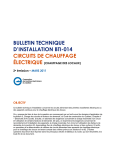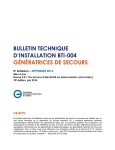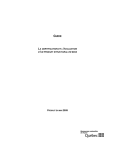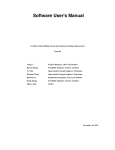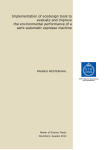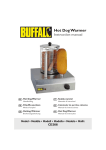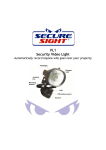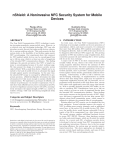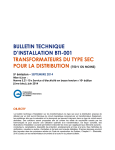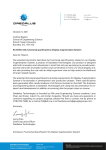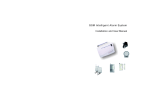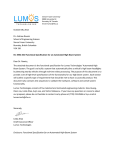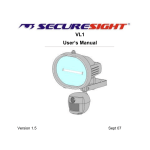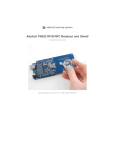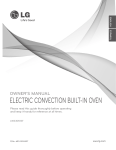Download Functional Specification for a Smart Locker
Transcript
School of Engineering Science Simon Fraser University Burnaby, BC V5A 1S6 [email protected] October 12, 2014 Dr. Andrew Rawicz School of Engineering Science Simon Fraser University Burnaby, British Columbia V5A 1S6 Re: ENSC 305W/440W Functional Specification for the Smart Locker Dear Dr. Rawicz: Attached is a document from Tap Lock Inc. describing the functional specification for the Smart Locker. Our company is designing and implementing a smart locking system that can be controlled by smart phones via NFC (Near Field Communication). The whole system is consisted of a physical locker and a self-developed android-based application. It can assign access automatically and allow each user to share access just by tapping two smart phones together. The functional specifications provides all requirements for the entire system. This document will e used y Tap Lo k I .’s proje t a ager a d desig ers as a reference and design guide throughout the research and development process. Tap Lock Inc. consists of five intelligent, creative and motivated third and fourth-year engineering students: Wangyi Zhu, Yangyang Li, Kaiqi Li, Haishuo Zhang and Zheng Gao. If you have any questions or concerns about our project, please feel free to contact me by phone at (604)-767-8090 or by email at [email protected]. Sincerely, Wangyi Zhu President and CEO Tap Lock Inc. Enclosure: Functional Specification for the Smart Locker Copyright ©2014 Tap Lock Inc. Functional Specification for a Smart Locker Project Team: Wangyi Zhu Yangyang Li Haishuo Zhang Kaiqi Li Zheng Gao Contact Person: Wangyi Zhu [email protected] Submitted to: Dr. Andrew Rawicz – ENSC 440W Steve Whitmore – ENSC 305W School of Engineering Science Simon Fraser University Issue Date: October 14, 2014 Revision: 1.6 Copyright ©2014 Tap Lock Inc. Functional Specification For a Smart Locker Executive Summary At the beginning of each semester in some universities like SFU, students have to finish several steps to request a locker, by sending an email. However, the existing system is very complicated and time-consuming: after sending out an email, stude ts ha e to ait for ad i istrator’s appro e to set up a d o tai the lo ker’s pass ord. As technology developed, many advanced locking systems have been created to simplify people’s life, su h as RFID lo kers. Although this i o atio has introduced a new generation of electronic locking system, it only provides an easier way of opening and locking a locker. In other word, the existing lo ki g syste i the arket is ot i tellige t e ough to i pro e users’ experience and maximize the power of technology. The Smart Locker from Tap Lock Inc. seeks to provide users with a multifunctional, easy-to-use and very secure electronic locking system via NFC. The user can access the locker by just tapping their smart phones to the locker. In addition to this easy-to-use function, users can also request locker, sharing access through smart phone application and have their user information and locker identities pre-recorded in database for security purpose. There are two phases of our Smart Locker development. The first phase includes functions as shown below: Saving user information in database Saving locker identity in database Assigning access automatically Opening and locking the locker via NFC Sharing access via NFC by tapping two smart phones together Self- alarm system All operations above are controlled through an easy-to-use Android application. This application can increase efficiency and security of user experience. This prototype phase is planned to be finished in a four-month development cycle and to be completed on December 6, 2014. In the second phase of development, we aim to extend usage of this electronic system. For exa ple, stude ts a use our A droid appli atio to a ess s hool’s pri ters a d finish the payment. Tap Lock Inc. is committed to create an intelligent system that not only allow user to easily open lockers but also simplify the school life in various ways. Moreover, the Smart Locker will comply with correlative standard including CSA, IEC and ISO. Copyright ©2014 Tap Lock Inc. ii Functional Specification For a Smart Locker Table of Contents Executive Summary............................................................................................................................................... ii Table of Figures ..................................................................................................................................................... v Glossary................................................................................................................................................................. v 1. Introduction .................................................................................................................................................. 1 1.1 Scope .................................................................................................................................................... 1 1.2 Intended audience ............................................................................................................................... 1 1.3 Classification ........................................................................................................................................ 1 2. First Phase - Prototype ................................................................................................................................. 2 3. Second Phase - Final Product ....................................................................................................................... 2 4. System Overview .......................................................................................................................................... 2 5. System Requirements................................................................................................................................... 3 6. 7. 5.1 General requirements .......................................................................................................................... 3 5.2 Physical requirements .......................................................................................................................... 3 5.3 Electrical requirements ........................................................................................................................ 4 5.4 Mechanical requirements .................................................................................................................... 4 5.5 Environmental requirements ............................................................................................................... 4 5.6 Standards ............................................................................................................................................. 4 5.7 Reliability and Durability ...................................................................................................................... 4 5.8 Safety requirements............................................................................................................................. 4 5.9 Performance requirements .................................................................................................................. 4 5.10 Usability requirements ......................................................................................................................... 5 Server............................................................................................................................................................ 5 6.1 General Requirements ......................................................................................................................... 5 6.2 Functional Requirements ..................................................................................................................... 5 6.3 Reliability Requirements ...................................................................................................................... 5 6.4 Environmental Requirements .............................................................................................................. 5 6.5 Performance Requirements ................................................................................................................. 5 6.6 Security Requirements ......................................................................................................................... 5 NFC Reader and NFC Tag .............................................................................................................................. 5 7.1 Electrical Requirements ....................................................................................................................... 6 7.2 Reliability Requirements ...................................................................................................................... 6 Copyright ©2014 Tap Lock Inc. iii Functional Specification For a Smart Locker 7.3 Safety requirements............................................................................................................................. 6 7.4 Performance requirements .................................................................................................................. 6 8. Arduino ......................................................................................................................................................... 6 8.1 Electrical requirements ........................................................................................................................ 6 8.2 Reliability Requirements ...................................................................................................................... 6 8.3 Safety requirements............................................................................................................................. 6 8.4 Performance requirements .................................................................................................................. 6 9. Android APP.................................................................................................................................................. 7 9.1 General Requirements ......................................................................................................................... 7 9.2 Functional Requirements ..................................................................................................................... 7 9.3 Reliability Requirements ...................................................................................................................... 7 9.4 Performance Requirements ................................................................................................................. 7 10. Documentation......................................................................................................................................... 8 11. Sustainability and Safety Considerations ................................................................................................. 8 12. Conclusion ................................................................................................................................................ 9 13. References .............................................................................................................................................. 10 Copyright ©2014 Tap Lock Inc. iv Functional Specification For a Smart Locker Table of Figures Figure 1: Smart Locker Functional Block Diagram .......................................................................... 2 Glossary NFC RFID CSA ISO IEC Near Field Near Field Communication Radio-frequency identification Canadian Standards Association International Organization for Standardization International Electrotechnical Commission De i es are ery losed to ea h other’s a te a, ithi a dista e of . Copyright ©2014 Tap Lock Inc. v Functional Specification For a Smart Locker 1. Introduction The Smart Locker is an electronic locking system consists of closure and an Android-based smart phone application. This system allows the user to control the closure through smart phones via NFC. Also, locker requesting and accessibility authorizing can be done automatically through the syste . For se urity purpose, user’s i for atio a d lo ker’s ide tities are sa ed i database. Moreover, primary user has rights to share access to whomever they want by tapping two smart phones together. Detailed requirements for the Smart Locker, proposed by Tap Lock Inc., are described in this functional specification. 1.1 Scope This document describes the functional requirements that must be met by the Smart Locker. The outlined details describe the functionalities of our proof-of-concept prototype. This document is expected for use in future development and improvement of the product. 1.2 Intended audience The functional specification is intended to use by all members of Tap Lock Inc. The project manager shall refer to the functional specification as a guidance to measure progress during development period. Design engineers shall refer to the requirements as overall design goals and foresee the potential risks involved in implementation. Test engineers shall use this document as guidance in trouble-shooting and debugging. 1.3 Classification Throughout this document, the following convention shall be used to denote functional requirements: [Rn-p] A functional requirement. Where n is the functional requirement number, and p is the priority of the functional requirement based on following three levels: I First Priority II III Second Priority Third Priority Copyright ©2014 Tap Lock Inc. Requirement should be met for both prototype and final product Requirement should be met for the prototype Requirement should be met for the final product 1 Functional Specification For a Smart Locker 2. First Phase - Prototype As introduced, the Smart Locker is an electronic locking system which is based on NFC technology. The reason that Tap Lock Inc. choose NFC is due to the advantages of low-cost and near field. Compared to other radio communication technology, NFC chip has the cheapest price. In addition, the feature of near field allows user to set up the connection actively. Since smart phones are almost available to everyone nowadays, we choose to develop an application as the controller. The smart phone will act as a key so that the user shall no longer remember a password. Basically, our prototype is designed to simplify a traditional locking system and provides more functionalities such as sharing access and automatic registration. 3. Second Phase - Final Product Tap Lock Inc. believes that the NFC technology will have a massive expansion in the future market. So we aim to develop the prototype with more functions, such as contactless payment. This idea is considered due to increasing usage of mobile payment. The NFC technology can be used in many ways. Thus, we propose to design a system in school which not only provides students access to lockers but also assign access to other electronic equipment such as printers. 4. System Overview The Smart Locker system can be divided into three main components: server component, software component and locker component. A detailed system overview is shown in Figure 1: Figure 1: Smart Locker Functional Block Diagram Copyright ©2014 Tap Lock Inc. 2 Functional Specification For a Smart Locker As introduced previously, the Smart Locker contains a database which is described as the server component in the system. It saves all authentication information of each user and locker. Stored information is used to check the status of each locker, such as availability and keep in track with authorized permissions. Thus, once the user send out a request, the system can automatically check for availability, identify locker and assign access. Software component is the android smart phone application. This interface establishes the communication between lockers and database. Once the user tap the smart phone to the locker, the embedded system will start to scan the built-in NFC chip inside the locker so that to communicate with the server component. Once the request has been approved, the server will send a NDEF to the locker component and give permission to open the closure. The last part of our electronic locking system is the locker component, which is also the physical component. It consists of a NFC tag, a NFC shield on Arduino board and a magnetic lock. The server component can be considered as the brain of entire system, storing data and controlling the other two components. The software component is like a central nervous system that determines the overall functionalities and transmits signals between components. However, the locker component acts as bones and skins of a human body. It determines the strength and safety of our locking system. 5. System Requirements This section introduces all the requirements for the prototype and final version of Smart Locker. 5.1 General requirements [R1-I] The system shall be easy to install [R2-III] The smart phone application shall be available on Google Play Store [R3-I] The retail price of the application shall be under $5.00 [R4-I] The system shall be cheap to maintenance 5.2 Physical requirements [R5-I] The metallic locker should be well insulated [R6-I] The closure shall have round edges [R7-III] The closure shall have a similar appearance to a regular closure [R8-I] Each single closure shall not weight more than 10 Kg [R9-I] The maximum dimension of a closure shall be under 80x80x80 cm Copyright ©2014 Tap Lock Inc. 3 Functional Specification For a Smart Locker 5.3 Electrical requirements [R10-III] Back-up power supply shall be run under power outage [R11-II] The system shall be usable with a wall supply at 110V 5.4 Mechanical requirements [R12-II] The door of each closure shall be easy to open [R13-III] The clapboard of each closure shall be able hold a maximum weight of 60Kg 5.5 Environmental requirements [R14-II] The system shall be installed indoors [R15-III] The system shall be able to operate under a temperature range from 0 to 60℃ 5.6 Standards [R16-I] The electronic components shall conform to C22.2 NO.60335 standards [1] [R17-I] The system shall conform to IEC 60364-1 standards [2] [R18-I] The system shall conform to CSA Z462-12 standards [3] [R19-I] The system shall conform to CSA Z463 standards [4] 5.7 Reliability and Durability [R20-I] The closure shall be able to resistant to mechanical damage caused by human force [R21-I] The user interface shall be resistant to breakage under normal operating conditions [R22-III] The system shall be serviceable by trained technicians [R23-I] The system shall be able to work continuously once powered on 5.8 Safety requirements [R24-I] The system shall be able to alarm when opened by force [R25-III] The system shall be able to detect electrical failure. If any failure is detected, the system shall send feedbacks for maintenance [R26-I] The electronic NFC chip built-in locker shall not create any electrical shock when user touch it [R27-I] The system shall not produce harmful radiation 5.9 Performance requirements [R28-III] The LED lights shall indicate user whether the closure has been successfully locked Copyright ©2014 Tap Lock Inc. 4 Functional Specification For a Smart Locker [R29-III] The locker shall be opened within 1 second 5.10 Usability requirements [R30-III] The syste ’s firmware shall be upgradeable by trained technicians [R31-III] The metallic shell of the locker shall be able to protect the NFC chip from ducts and vapor 6. Server The Server communicates with the Android APP to verify credentials, add new users, provide digital locker keys and etc. 6.1 General Requirements [R32-I] The server should be setup on a desktop with 4G RAM, 200G storage and an Intel i3 or better CPU 6.2 Functional Requirements [R33-I] The server should be able to receive data from the Android APP [R34-I] The server should be able to send data to the Android APP 6.3 Reliability Requirements [R35-I] The server should always send correct data to the Android APP 6.4 Environmental Requirements [R36-I] The server should operate normally under room temperature 6.5 Performance Requirements [R37-I] The server should not take more than 5 seconds to respond to any request made by the Android APP 6.6 Security Requirements [R38-I] The server should only allow authenticated users of the Android APP to modify the content of the database or to retrieve information from the server 7. NFC Reader and NFC Tag NFC reader reads data from smart phones and transfers data to Arduino. NFC tag sends data to smart phones. Copyright ©2014 Tap Lock Inc. 5 Functional Specification For a Smart Locker 7.1 Electrical Requirements [R39-I] NFC reader should be powered up by Arduino. NFC tag should get power from smart phone 7.2 Reliability Requirements [R40-III] NFC reader should read data from smart phone from different brands and NFC tag should send data to the smart phone before installed to the locker 7.3 Safety requirements [R41-I] The connection between NFC reader and Arduino should be properly wired to prevent any possible shortage [R42-I] A case should be applied to NFC reader and tag to prevent users from touching 7.4 Performance requirements [R43-I] NFC reader should be able to read data from smart phones and send data to Arduino [R44-I] NFC tag should be able to send data to smart phones 8. Arduino Arduino send data to NFC reader and also analyses data from NFC reader to decide whether open the locker or decline the request. 8.1 Electrical requirements [R45-I] Arduino should be powered up by a 5V source, which comes from voltage regulator [R46-I] Arduino should able to power up NFC reader 8.2 Reliability Requirements [R47-I] Arduino should pass basic functional test before install into the locker 8.3 Safety requirements [R48-I] The connection between Arduino and other devices should be properly wired to prevent any possible shortage [R49-I] A case should be applied to Arduino board to prevent users from touching it 8.4 Performance requirements [R50-I] Arduino should able to talk to NFC reader and get data from it [R51-I] Arduino should able to talk to electromagnetic lock and control it Copyright ©2014 Tap Lock Inc. 6 Functional Specification For a Smart Locker 9. Android APP The software application is developed for android smart phones. It set up the communication between NFC chip built-in locker and the server. Multi-functions are designed to perform various tasks, such as sending closure requests and share access. 9.1 General Requirements [R52-I] The user interface shall be easy to use [R53-I] The application shall install automatically once download from Google Play Store [R54-I] The application shall be able to compatible to different android-based smart phones 9.2 Functional Requirements [R55-I] The User has to be able to register for an account [R56-I] The user has to be able to login in the APP if account is valid [R57-I] The user has to be able to register for a locker [R58-I] The user has to be able to cease ownership of a locker under his/her name [R59-I] The user has to be able to unlock a locker under his/her name [R60-I] The user has to be able to authorize another registered user to open one of the lockers under his/her name [R61-I] The user shall be able to change password once logged in or through the forgotten password option 9.3 Reliability Requirements [R62-I] The application shall not contain any bugs that will cause system crashes 9.4 Performance Requirements [R63-I] The application shall pop up error message when failure occurs [R64-I] The application shall inform the user when upgrade is available [R65-I] The application shall react within 2 seconds when two smart phones are tapping together to share access [R66-I] A quick-start guide shall be performed once the application finished installation Copyright ©2014 Tap Lock Inc. 7 Functional Specification For a Smart Locker 10. Documentation [R67-I] User documentation shall be available on company website with general and technical support information [R68-I] The user manual shall include graphics, text, and step by step instructions to guide users how to install and operate the system [R69-I] Contact information shall be available for customer service 11. Sustainability and Safety Considerations As introduced, the Smart Locker of Tap Lock Inc. consists of three main components: server component, software component and locker component. Basically, the server component is the database of the system and software component is software code. Thus there will be no waste in server and software component. For the locker component, Arduino is a reprogrammable microchip, so if lock is abandon, user still can reuse the Arduino for other projects. The locker is totally grounded and user will not be shocked by electric. Copyright ©2014 Tap Lock Inc. 8 Functional Specification For a Smart Locker 12. Conclusion This document clearly states the function specification of the Smart Locker. Development of the product will take place in two phases: proof-of-concept and prototype. The Smart Locker prototype shall contain a metallic closure, an android smart phone application and a server. It will allow the user to open the locker by smart phones via NFC. Moreover, the prototype shall meet the listed requirements throughout the development. Further improvements and expansions of functionalities will be considered. Extra requirements are listed as well for future design. This prototype is expected to be completed by December 6th, 2014. Copyright ©2014 Tap Lock Inc. 9 Functional Specification For a Smart Locker 13. References [1] CSA. (2012) C22.2 NO.60335 [online] Available: http://shop.csa.ca/content/ebiz/shopcsa/resources/documents/CSA-Group-ElectricalSafety-WhitePaper.pdf [2] IEC. (2005) fifth edition, IEC 60364-1 [online] Available: ftp://preview.iec.ch/preview/info_iec60364-1%7Bed5.0%7Den_d.pdf [3] CSA. (2008) second edition, CSA Z462-12 [online] Available: http://shop.csa.ca/en/canada/landing-pages/z462-workplace-electricalsafety/page/z462?source=Topsellers_Bestsellers [4] CSA. (2012) CSA Z463 [online] Available: http://shop.csa.ca/content/ebiz/shopcsa/resources/documents/Z463WhitePaper.pdf [5] Near Field Communication: http://www.nearfieldcommunication.org/payment-systems.html [6] Mobile Payments Today: http://www.mobilepaymentstoday.com/topics/ Copyright ©2014 Tap Lock Inc. 10
















